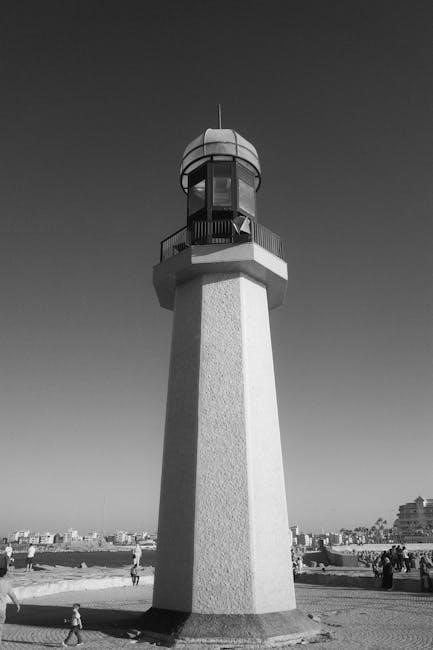
guide ulysse
Welcome to Guide Ulysse, your essential companion for exploring James Joyce’s Ulysses. This comprehensive guide offers in-depth resources, analysis, and insights to enhance your reading journey.
Overview of the Novel “Ulysses” by James Joyce
James Joyce’s Ulysses is a groundbreaking modernist novel that reimagines Homer’s Odyssey in Dublin on June 16, 1904. The story follows Leopold Bloom, a Jewish advertising canvasser, as he navigates the city, paralleling Odysseus’s journey home. The novel also features Stephen Dedalus, a young artist, and Molly Bloom, Leopold’s wife, whose voices intertwine to explore themes of identity, home, and human experience. Written in a revolutionary stream-of-consciousness style, Ulysses captures the inner thoughts and emotions of its characters, offering a profound glimpse into everyday life. Despite initial controversy, it is now celebrated as one of the most influential works of 20th-century literature.
The Importance of a Reading Guide for “Ulysses”
A reading guide is essential for navigating James Joyce’s Ulysses, a novel renowned for its complexity and modernist style. The guide provides clarity on the book’s intricate structure, stream-of-consciousness narrative, and numerous allusions to Homer’s Odyssey. It helps readers decipher challenging passages, understand Joycean terminology, and appreciate the novel’s historical and cultural context. With summaries, character analyses, and thematic insights, a guide enhances comprehension and deepens the reader’s connection to the text. Whether you’re a first-time reader or revisiting the novel, a guide ensures a more fulfilling and informed reading experience, unlocking the richness of Joyce’s masterpiece.

Historical and Cultural Context
Set in Dublin in 1904, Ulysses portrays a fast-growing, diverse, yet relatively poor colonial city, home to 400,000 people, shaping the characters’ experiences and cultural identity.
Ulysses as a Modernist Reconstruction of Homer’s “Odyssey”

James Joyce’s Ulysses reimagines Homer’s Odyssey in a modern Dublin setting, blending ancient epic themes with 20th-century urban life. Each of the novel’s 18 episodes mirrors an Odyssey episode, with Leopold Bloom as the modern Odysseus, Molly Bloom as Penelope, and Stephen Dedalus as Telemachus. Joyce’s innovative narrative techniques, such as stream-of-consciousness, redefine the classical hero’s journey, focusing on everyday struggles and inner monologues. This reconstruction not only pays homage to Homer but also explores identity, belonging, and the human condition in a contemporary context, making Ulysses a landmark of Modernist literature.

Dublin in 1904: Setting and Significance
Dublin in 1904 serves as the vibrant backdrop for Ulysses, capturing the city’s essence during a period of cultural and political shift. Joyce meticulously portrays Dublin’s streets, pubs, and landmarks, creating a vivid sense of place. The city, with its diverse population and colonial influences, reflects the broader themes of identity and belonging; As a setting, Dublin is not just a location but a character in itself, shaping the lives of Leopold Bloom, Stephen Dedalus, and Molly Bloom. Joyce’s intimate knowledge of the city, despite his eventual exile, ensures its authenticity. For modern readers, understanding the historical and cultural context of Dublin in 1904 is essential to fully appreciating the novel’s depth and complexity.
Irish History and Identity in the Novel
Irish history and identity are central themes in Ulysses, as Joyce explores the complexities of Irish culture and nationalism. Set in 1904, the novel reflects a Dublin shaped by colonial rule and emerging Irish identity. Characters like Stephen Dedalus and Leopold Bloom embody this duality: Stephen struggles with his Irishness and artistic ambition, while Bloom, of Jewish heritage, navigates his place in Irish society. Joyce weaves historical references, such as the Gaelic Revival and Catholicism, into the narrative, highlighting Ireland’s cultural and political tensions. The novel becomes a mirror of Ireland’s quest for self-definition, blending personal and national identities in a rich, layered tapestry. This exploration remains vital for understanding the novel’s depth and relevance.

Structure and Episodes
Ulysses is divided into 18 episodes, each mirroring Homer’s Odyssey. Joyce’s modernist narrative weaves stream-of-consciousness storytelling, creating a rich, interconnected exploration of Dublin life in 1904.
The 18 Episodes of “Ulysses” and Their Homeric Parallels
Ulysses is structured into 18 episodes, each drawing parallels to Homer’s Odyssey. Joyce’s modernist reinterpretation aligns Leopold Bloom with Odysseus, Molly Bloom with Penelope, and Stephen Dedalus with Telemachus. Each episode mirrors an Odyssean adventure, from Telemachus’s introspection to Molly’s fidelity. The Lotus-Eaters episode reflects the allure of indulgence, while Hades explores mortality. Joyce’s Dublin becomes a modern Ithaca, where Bloom navigates urban trials. These parallels enrich the narrative, blending ancient themes with 20th-century life, creating a profound exploration of identity, home, and human experience. Joyce’s innovative structure transforms the epic into a intimate, modern journey.
Episode 1: Telemachus
Episode 1, Telemachus, introduces Stephen Dedalus, Buck Mulligan, and Haines in a Martello tower. Stephen’s introspective nature and artistic struggles are central, reflecting his search for identity. The episode establishes themes of nationality, faith, and intellectual conflict. Mulligan’s mockery contrasts with Stephen’s seriousness, highlighting tensions between modernity and tradition. The tower itself symbolizes isolation and the characters’ disconnection from Dublin’s vibrant life. This episode sets the tone for Stephen’s journey, exploring his inner world and the complexities of his artistic ambition. Joyce’s vivid dialogue and imagery immerse readers in the characters’ dynamics, preparing them for the deeper psychological explorations ahead.
Episode 2: Nestor
Episode 2, Nestor, shifts the focus to Stephen Dedalus teaching history at a Dublin school. The episode explores themes of history, identity, and nationality through Stephen’s interactions with his students and Mr. Deasy. Stephen’s intellectual detachment contrasts with the practical, grounded worldview of Mr. Deasy, highlighting his alienation. The discussion of horse racing and Mr. Deasy’s letter about foot-and-mouth disease underscores the mundane aspects of life. This episode delves into Stephen’s struggles with authority and tradition, foreshadowing his eventual departure from conventional structures. The tension between past and present, as well as individual and collective identity, is central to this chapter.
Episode 3: Proteus
Episode 3, Proteus, delves into Stephen Dedalus’s introspective walk along Sandymount Strand. The narrative adopts a fluid, stream-of-consciousness style, mirroring the ever-changing nature of thought. Stephen grapples with philosophical questions about art, identity, and existence, reflecting his intellectual and emotional turmoil. His meditations on Aristotle, Plato, and Shakespeare reveal his deep engagement with intellectual traditions. The protean title reflects the episode’s dynamic, shape-shifting quality, as Stephen’s thoughts flow unpredictably. This chapter is a pivotal exploration of Stephen’s inner world, showcasing Joyce’s innovative narrative techniques and the character’s quest for artistic and existential meaning.
Episode 4: Calypso
Episode 4, Calypso, introduces Leopold Bloom in his home at 7 Eccles Street, Dublin. The episode follows Bloom’s morning routine, emphasizing the mundane yet intimate details of his life. His wife, Molly, remains in bed, and their interactions highlight the tension and familiarity of their relationship. The narrative shifts between Bloom’s practical tasks, such as cooking breakfast, and his introspective thoughts. This episode mirrors the Homeric Calypso, where Odysseus is held captive by the nymph Calypso, symbolizing Bloom’s emotional confinement within his marriage. The focus on domesticity contrasts with Stephen’s intellectual musings in earlier episodes, grounding the story in the everyday while exploring deeper emotional currents.
Episode 5: Lotus-Eaters
Episode 5, Lotus-Eaters, follows Leopold Bloom as he visits the post office, bank, and church, showcasing his daily routines and interactions. The episode is named after the Lotus-Eaters from Homer’s Odyssey, symbolizing temptation and indulgence. Bloom’s calm demeanor and acceptance of life’s pleasures contrast with the Homeric themes of resistance. The narrative explores themes of desire, relaxation, and the allure of comfort, reflecting Bloom’s pragmatic approach to life. This episode highlights Joyce’s ability to blend the mundane with deeper symbolic meaning, offering insight into Bloom’s character and the modern human condition. The Lotus-Eaters episode is a serene yet profound interlude in Bloom’s journey.
Episode 6: Hades
Episode 6, Hades, is one of the most accessible episodes in Ulysses, following Leopold Bloom as he attends a funeral at Glasnevin Cemetery. The episode parallels the journey of Odysseus through the underworld, evoking themes of mortality, grief, and remembrance. Bloom’s observations of the funeral rites and his reflections on death provide deep insight into his character. The narrative is linear and somber, contrasting with earlier episodes. Joyce uses this episode to explore the human experience of loss and the inevitability of death, while also highlighting Bloom’s empathetic nature. Hades serves as a poignant reminder of life’s fragility, resonating throughout the novel.
Episode 7: Aeolus
Episode 7, Aeolus, takes place in the offices of the Freeman’s Journal and Evening Telegraph, where Leopold Bloom and Stephen Dedalus cross paths. This episode parallels the story of Aeolus, the Greek god of the winds, who gave Odysseus a bag of winds to aid his journey. Joyce uses newspaper headlines to structure the narrative, reflecting the chaotic and fragmented nature of modern communication. Themes of rhetoric, persuasion, and the power of language are central, as characters engage in debates and discussions. Bloom’s quiet observation contrasts with the loud, argumentative atmosphere, while Stephen’s intellectual musings highlight his growing alienation. The episode critiques the superficiality of public discourse, offering a sharp commentary on modern society.
Episode 8: Lestrygonians
Episode 8, Lestrygonians, focuses on Leopold Bloom’s wanderings through Dublin as he seeks lunch. Named after the cannibalistic Lestrygonians from Homer’s Odyssey, this episode explores themes of hunger, consumption, and excess. Bloom’s visit to the Burton Hotel highlights societal gluttony, contrasting with his own modest sandwich. Joyce employs vivid, humorous imagery to critique the excesses of modern life. The episode also delves into Bloom’s reflections on food, culture, and identity, offering a satirical view of Dublin’s dining habits. Through this, Joyce underscores the human condition’s duality—between indulgence and restraint, excess and simplicity. This episode is a vibrant commentary on consumption and its societal implications.
Episode 9: Scylla and Charybdis
Episode 9, Scylla and Charybdis, is set in the National Library of Ireland, where Stephen Dedalus engages in a lively discussion about Shakespeare’s works. This episode is notable for its dense, philosophical tone and its exploration of artistic theory. Stephen presents his interpretation of Hamlet, arguing that the play reflects Shakespeare’s personal life and emotional struggles. The title, referencing the sea monsters from Homer’s Odyssey, symbolizes the intellectual and creative challenges Stephen faces. Joyce uses this episode to delve into themes of identity, artistry, and the search for meaning, showcasing Stephen’s intellectual depth and his ongoing struggle with his own artistic ambitions. This episode is a cornerstone of Ulysses’s intellectual and philosophical core;
Episode 10: Wandering Rocks
Episode 10, Wandering Rocks, marks a shift in narrative style, employing a fragmented, mosaic-like structure to depict multiple characters navigating Dublin. Named after the Wandering Rocks from Homer’s Odyssey, this episode captures the fluidity of urban life. Joyce interweaves brief, disconnected scenes, showcasing the movements of Leopold Bloom, Stephen Dedalus, and other characters. The episode’s complexity lies in its non-linear progression, with each section focusing on different individuals and locations. This technique emphasizes the simultaneity of events and the interconnectedness of lives in Dublin. Wandering Rocks is a masterful demonstration of Joyce’s experimental approach, blending realism with modernist innovation to create a vivid portrait of the city and its inhabitants.

Reading Guides and Resources
Discover essential reading guides and resources to navigate James Joyce’s Ulysses. From detailed episode analyses to historical context, these tools enrich your understanding of the novel’s complexity and depth.
Recommended Reading Habits for “Ulysses”
For a rewarding experience with Ulysses, adopt a structured approach. Set a schedule, aiming to read one episode per week, allowing time for reflection. Tackle the first eight episodes in a single sitting or within a day to maintain continuity. Engage deeply with the text by reading episode guides beforehand to unlock hidden meanings. Embrace patience and persistence, as the novel’s complexity rewards slow, thoughtful reading. Join online communities or discussion groups to share insights and gain perspectives. By combining personal study with external resources, you’ll navigate Joyce’s masterpiece with confidence and appreciation.
Essential Resources for Understanding the Novel
To fully grasp Ulysses, equip yourself with key resources. An episode-by-episode guide provides crucial context, uncovering Joycean references and historical nuances. Maps of Dublin and photographic guides help visualize the novel’s setting. Online communities and forums offer vibrant discussions, while annotated editions reveal hidden meanings. Secondary literature, such as critical essays, deepens understanding of themes and characters. Combining these tools enriches your reading experience, making Joyce’s masterpiece accessible and rewarding. Utilize these resources to navigate the novel’s complexity with confidence and uncover its rich layers of meaning.
Online Guides and Communities for Readers
Online resources are invaluable for navigating Ulysses. Websites like UlyssesGuide.com offer detailed episode breakdowns, historical context, and maps of Dublin. Forums and social media groups dedicated to Joyce’s work provide spaces for discussion and shared insights. Many readers benefit from interactive guides that track character arcs and themes. Additionally, academic websites and blogs often feature essays and analyses that shed light on the novel’s complexities. Engaging with these online communities can enhance your understanding and connection to the text, making the reading experience more enriching and collaborative.

Themes and Symbolism
Ulysses explores profound themes like identity, home, and belonging, woven with rich symbolism. Dublin itself becomes a symbol of cultural and historical complexity, reflecting the characters’ inner journeys.
The Theme of Identity in “Ulysses”
The theme of identity in Ulysses is central, as Joyce explores how characters navigate their sense of self in early 20th-century Dublin. Leopold Bloom, the modern Odysseus, grapples with his Jewish heritage and alienation in a predominantly Catholic city. His internal monologue reveals a complex, fragmented identity, shaped by personal history and societal expectations. Meanwhile, Stephen Dedalus struggles with his artistic and intellectual aspirations, questioning his role in Ireland and the world. Through their journeys, Joyce examines how identity is shaped by nationality, religion, and personal experiences, offering a profound commentary on the human condition and the search for belonging in a changing world.

Exploring the Concept of Home and Belonging
The concept of home and belonging in Ulysses is deeply intertwined with identity and place. Joyce portrays Dublin as a city where characters seek connection yet often feel alienated. Leopold Bloom, a wandering figure, embodies the tension between displacement and the desire for home. His Jewish heritage and marital life reflect a search for belonging in a city where he is both familiar and foreign. Similarly, Stephen Dedalus struggles with his artistic ambitions and familial ties, questioning where he truly belongs. Joyce’s Dublin becomes a character in itself, offering a sense of familiarity yet highlighting the characters’ emotional detachment. This duality underscores the universal human quest for a place to call home.

Symbolism in the Novel: Key Elements and Their Meanings
Ulysses is rich in symbolism, with elements that mirror Homer’s Odyssey and reflect early 20th-century Dublin. Odysseus’s journey home symbolizes the universal quest for identity and belonging. The color white, notably in the “Lotus-Eaters” episode, represents purity and Molly Bloom’s enigmatic presence. Music, particularly in Stephen’s thoughts, symbolizes artistic expression and emotional depth. The kidney and liver Bloom cooks embody life’s duality and mortality. Water, especially the River Liffey, symbolizes the flow of life and the subconscious. These symbols weave together, creating a layered narrative that explores humanity’s complexities and the search for meaning in everyday life.

Character Analysis
Ulysses explores complex, dynamic characters like Leopold Bloom, Molly, and Stephen Dedalus, each representing distinct facets of human identity, struggle, and the search for meaning in modern life.
Leopold Bloom: The Modern Odysseus
Leopold Bloom, the protagonist of Ulysses, embodies the modern Odysseus, navigating the mundane yet profound challenges of Dublin in 1904. His journey mirrors Odysseus’s epic quest, but in a contemporary urban setting. Bloom’s character is defined by his resilience, curiosity, and quiet kindness, making him deeply relatable. As a Jewish man in Dublin, he represents the outsider, yet his universal humanity connects him to readers. His wanderings through the city, from breakfast to bedtime, reveal the richness of ordinary life, transforming the everyday into the extraordinary. Through Bloom, Joyce reimagines the hero’s journey, emphasizing the beauty of the unheroic and the significance of human connection.
Molly Bloom: The Contemporary Penelope
Molly Bloom, Leopold’s wife, serves as a modern counterpart to Penelope, embodying strength and independence. Her infamous soliloquy reveals her inner world, filled with desires, memories, and reflections on life; Unlike the passive Penelope, Molly is a vibrant, sensual woman navigating her own identity beyond marriage. Her character challenges traditional roles, offering a complex portrayal of femininity. Molly’s voice adds depth to the narrative, showcasing her resilience and humanity. Through her, Joyce reimagines the ancient archetype, creating a figure who is both timeless and distinctly modern, symbolizing the enduring power of life and individuality in the face of societal expectations.
Stephen Dedalus: The Struggling Artist
Stephen Dedalus, a central figure in Ulysses, embodies the archetype of the struggling artist, grappling with identity, faith, and creativity. As a young intellectual, he seeks to define himself beyond his past and familial ties, striving for artistic expression; His journey reflects his internal conflict between spirituality and rationality, as well as his ambition to transcend mundane life. Through his interactions with Leopold Bloom, Stephen’s character evolves, revealing vulnerabilities and growth. His struggles mirror the universal quest for meaning, making him a deeply relatable and complex figure in Joyce’s masterpiece. Stephen’s story becomes a metaphor for the artist’s eternal search for purpose and authenticity in a changing world.
Ulysses remains a seminal work in modern literature, offering profound insights into human experience. For deeper exploration, explore critical essays, analyses, and scholarly discussions that expand its themes.
Final Thoughts on Reading “Ulysses”
Reading Ulysses is a profound literary journey that challenges and rewards readers in equal measure. While its complexity can feel overwhelming, persistence reveals its rich layers of meaning. The novel’s exploration of identity, home, and human connection resonates deeply, offering insights into the universal human experience. For first-time readers, a guide can be invaluable, helping to decode references and themes. Ultimately, Ulysses is a celebration of life’s ordinary moments, elevating the mundane to the extraordinary. Embrace the journey, and let the guide illuminate your path through Joyce’s masterpiece.
Recommended Secondary Literature and Criticism
For deeper understanding, explore secondary literature like T.S. Eliot’s essays on Joyce and Harold Bloom’s analysis of Ulysses. Critiques by scholars such as Virginia Woolf and Ezra Pound offer unique perspectives. Modern analyses, including feminist and postcolonial interpretations, provide fresh insights. Academic journals and dedicated Joyce studies journals are invaluable. Online forums and communities also share diverse viewpoints. These resources enrich your reading experience and offer new ways to interpret the novel’s complexities. They are essential for scholars and enthusiasts alike, bridging the gap between Joyce’s vision and contemporary understanding.




